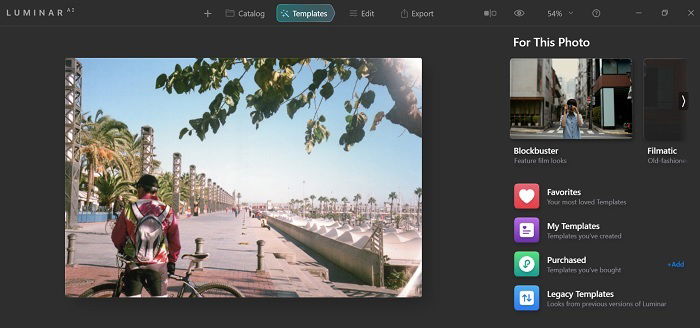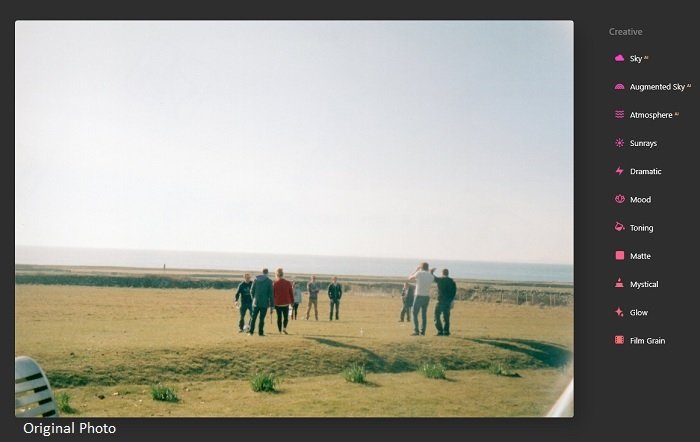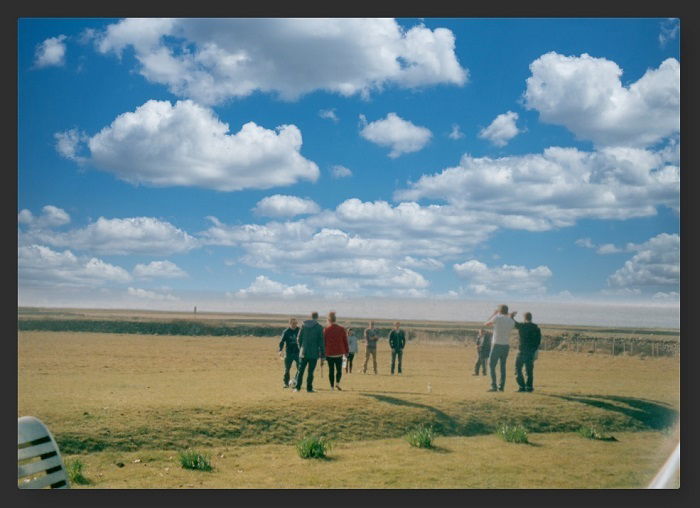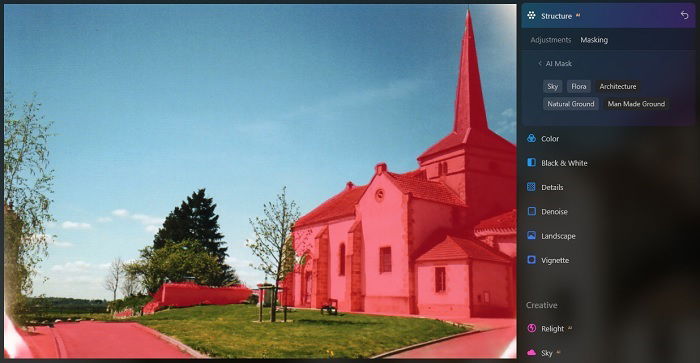Luminar Neo is designed for people who want to quickly edit their photos without spending too much time on each individual adjustment. It offers a wide range of presets and filters that make it easy to improve your photos with just a few clicks Luminar AI, on the other hand, is more geared towards professional photographers and advanced amateurs. It offers all of the same features as Luminar Neo, plus a number of additional tools that allow you to fine-tune your photos in greater detail
Templates vs. Presets
The templates were one of the flagship features in Luminar AI. They’re filters you can apply to any photo instantly. Select a photo, and the AI recommends templates suited to that kind of image. The templates are an excellent way to change the mood or atmosphere of your photos. You don’t need to make adjustments to different tools or filters. You simply select a template from the recommended list and it’s done.
Seeing as the templates were a headline feature in Luminar AI, some were surprised not to see them in Luminar Neo. But it didn’t take long to realize that “templates” in AI were renamed “presets” in Neo. The presets in Luminar NEO work in much the same way. The AI evaluates your photo and recommends presets from their library. Then you apply the preset of your choice with one click of your mouse. Other than the renaming, not much has changed. At the moment, you can’t create presets on Luminar Neo. But Skylum has informed us that this will become a feature at a later date.
Face AI
The face AI tools in Luminar NEO and Luminar AI are very similar. They have the same adjustment options and they both have the same slide bar operation. You can make the eyes bigger and brighter, and you can even change the color. You can also enhance the lips, making them redder and more pronounced. The face AI is an excellent tool for improving portraits. We were impressed with the face AI in Neo and Luminar AI. The two programs also feature the portrait bokeh AI and we were pleased with the results from both. <img class=“aligncenter wp-image-771808 size-full” src=“https://expertphotography.com/wp-content/uploads/2022/05/Luminar-Neo-vs-Luminar-AI-Neo-Face-AI.jpg" alt=“Screenshot of Luminar NEO face AI tool in operation” width=”700″ height=”601″ />
What Are The Main Differences?
The Core Engine
You might think the new features are the big difference between Luminar NEO and Luminar AI. But it’s the new core engine that lies at the heart of the Luminar NEO vs. Luminar AI debate. The AI tools in Luminar AI were impressive. But Luminar AI users complained of performance issues. It would run slowly and become glitchy and unresponsive if you applied more than one effect. We encountered these problems too. We believe this was a fundamental problem for Luminar AI. Skylum knew they couldn’t solve this issue with updates. They needed something new. Luminar Neo has a modular core engine. That means each editing area has a separate processor, improving performance for photo editors. The modular engine in Luminar NEO isn’t just a gimmick. Luminar NEO runs smoothly and applies all changes at lightning speed. We haven’t encountered any of the running issues found in Luminar AI, but it has slowed down slightly with each update. <img class=“aligncenter wp-image-772015 size-full” src=“https://expertphotography.com/wp-content/uploads/2022/05/Luminar-Neo-vs-Luminar-AI-Neo-Interface.jpg" alt=“Screenshot of Luminar NEO library interface” width=”700″ height=”387″ />
Power Line Removal AI
Any photo editor knows the pain of removing power lines manually. It’s painful and time-consuming, but Luminar NEO has the tool to save you hours of tedious work. The Power line removal is genuinely impressive. You’ll find it in the Erase tool drop-down menu. And you have the option to remove power lines as well as dust spots. Photo editors will love this fast and accurate AI tool.
Mask AI
The mask AI tool is another feature you’ll only find in Luminar Neo. It also has radial and linear masking options and a brush tool for local adjustments. But the AI masking is something completely new. The mask AI evaluates your image and identifies the elements within it. It identifies eight different categories. They are human, water, flora, transport, architecture, sky, natural ground, and man-made ground. You select the element you want to change, and it will highlight it in red. Then you make the adjustments you want. The masking option is available for many tools including structure AI, enhance AI, and augmented sky AI.
Layers
You have some layer options in Luminar AI. But Luminar NEO takes layering to a whole new level, giving you more options for creative image manipulation. Neo gives you a library of layers you can add to your images. But the library options are more like adjustable filters. The main improvement is the ability to add additional layers by importing PNG and JPEG files. The layer controls are what separate Luminar NEO from Luminar AI. These controls are totally new. And photo editors and digital artists alike will love using the layers and its straightforward user interface.
Luminar Neo vs. Luminar AI: The Verdict
There are two questions we set out to answer. Which is better? And which is better for you? But when it comes to Luminar NEO vs. Luminar AI, the answer to the first question makes the second question pointless. Luminar Neo is the better of the two programs. Luminar AI is cheaper and Luminar NEO is not yet complete, with updates still on the way. But everything Luminar AI does, Neo does better. And it does a whole lot more. The first thing to mention is the core engine. Neo’s modular engine removes most of the running issues that frustrated AI users. Luminar NEO runs like a dream in comparison. The templates were a popular part of Luminar AI. And Neo now has the presets, which are just as good. The AI tools, like face and bokeh AI, work well in both Luminar programs. But the Neo version encounters fewer hiccups. As the updates come in for Luminar Neo, the lead grows larger. We’re still waiting for the portrait background removal. But the mask AI and layers give Luminar NEO an even broader appeal. It’s perfect for photographers of all levels, social media creators, and digital artists. In the Luminar Neo vs. Luminar AI debate, there’s only one winner. Luminar Neo takes top prize as the best AI-powered photo editing software.














